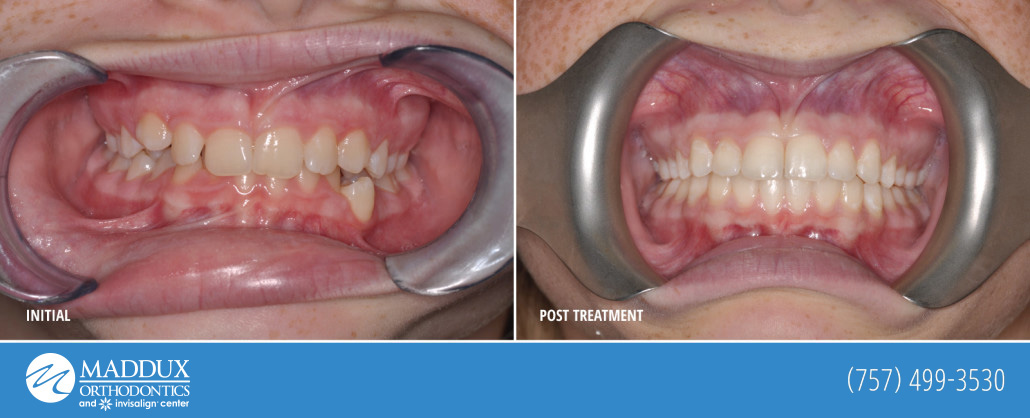 A bad bite, or malocclusion, happens when your upper and lower teeth are not properly aligned. It can be congenital or can result from childhood habits such as thumb sucking.
A bad bite, or malocclusion, happens when your upper and lower teeth are not properly aligned. It can be congenital or can result from childhood habits such as thumb sucking.
Bad bites come in a variety of forms and can have a variety of consequences. Dr. Nicholas Maddux of Maddux Orthodontics in Virginia Beach, VA, shares some information you need to know about orthodontic treatment for a bad bite.
Why do you Need to Fix a Bad Bite?
The consequences of an uncorrected bad bite vary depending on the nature of the problem, and bad bites generally do not self correct. A bad bite can result in any of the following:
- Speech difficulties.
- Food getting stuck between teeth, resulting in cavities or gum disease.
- Dry mouth.
- Upper teeth biting into lower gums and/or lower teeth biting into roof of mouth.
- Tongue biting.
- Early enamel wear.
- Swallowing problems.
- Cosmetic alteration to the appearance of the face.
- Lowered self esteem and a reluctance to smile with the mouth open.
- Interference with chewing.
- Strain on the muscles in the jaw, particularly if the person also grinds their teeth.
Thankfully, bad bites can be corrected. A trained orthodontist can use braces, clear aligners, or other treatments to fix a bad bite and restore the teeth and jaw to the correct, healthy position.
How Can Braces and Aligners Help?
For most issues, braces or clear aligners are considered the go-to solution to fix malocclusion. Braces are often needed to correct bite issues, but in some cases, clear aligners may be enough. It’s important to start treatment early; the earlier the treatment is started, the higher the chance of fully correcting the problem. Bite issues can be fixed in adults, but it generally takes longer and is more expensive; many adults find they have to live with the issue or are more likely to need surgery that they may not be able to afford.
Thus, it’s important to talk to an orthodontist as soon as you or your dentist realize there is a problem with your child’s bite. Your dentist will refer you to an orthodontist for ongoing treatment.
What Will Dr. Maddux Do?
An orthodontist will examine your child’s teeth and bite. They will also take X-rays and impressions of the teeth, which are a digital view of how the teeth align. They may also take photographs.
Once Dr. Maddux has determined the nature and the severity of the problem, he will talk to you about a course of treatment. As already mentioned, this most often involves braces or aligners, but there are some other options. These may include:
- Retainers. For very mild problems, a simple retainer worn at night might solve the issue.
- Surgery. It’s rare to need surgery to correct a bad bite, but it is possible.
- Reshaping or capping of teeth.
- Removal of teeth. The removal of permanent teeth is an option if the mouth is too small, and in some cases can prevent wisdom teeth from becoming impacted.
- The use of an orthodontic appliance to realign the jaw, such as a palatal expander.
While braces or clear aligners will be the primary treatment, some bite issues require a little bit more. Clear aligners are often better for comfort and aesthetics, but can’t fix all bite problems and sometimes reduce compliance in younger children.
A bad bite is a problem that should be fixed, and fixed early. Correcting it will help your child keep healthy teeth through their life, as well as improving their self-esteem and perception of their appearance. If your child has crooked teeth or an overbite or underbite (a small overbite is normal), then you should consider scheduling an appointment with an orthodontist.
Maddux Orthodontics offers complimentary consultations and experienced care for your child’s orthodontic needs. Contact us today to schedule an evaluation for your child’s bite! We can’t wait to make your child smile!
